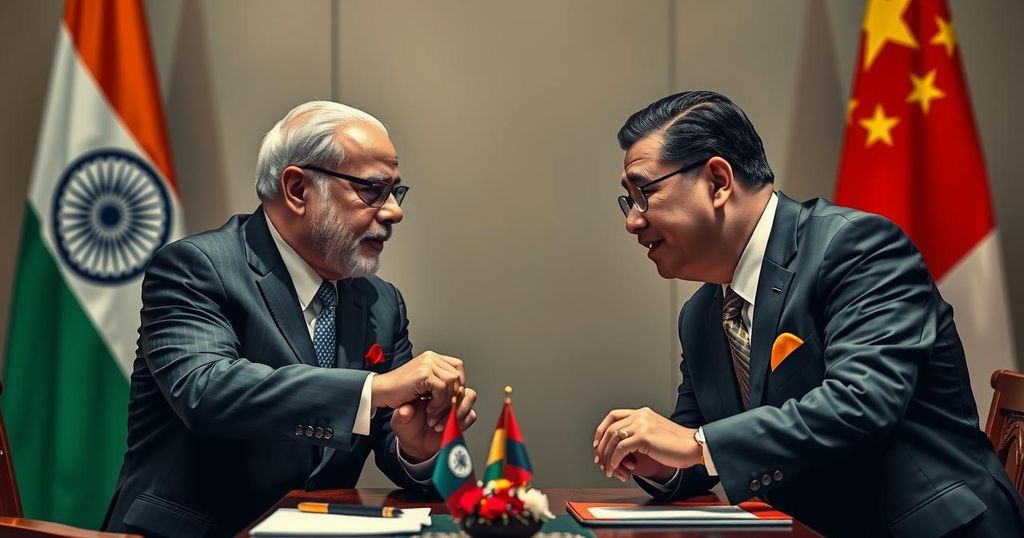During the recent BRICS summit in Russia, Prime Ministers Modi and Xi engaged in a significant bilateral meeting, marking an attempt to mend relations strained by a 2020 border clash. Following an agreement on troop disengagement along the disputed frontier, experts suggest this development signals a critical geopolitical shift in Asia and a possible pivot for India away from U.S. alignment. However, uncertainties remain regarding territorial claims and broader economic cooperation, amidst ongoing scrutiny of Chinese investments in India.
At the recent BRICS summit in Kazan, Russia, a pivotal moment for Sino-Indian relations emerged as Prime Ministers Narendra Modi and Xi Jinping engaged in their first comprehensive bilateral discussion in five years. This meeting aimed to alleviate tensions stemming from a violent 2020 clash along the Ladakh border, which had previously strained the relationship to a breaking point. Following the summit, it was reported by Indian Foreign Secretary Vikram Misri that both nations had agreed upon the disengagement of troops positioned along their disputed frontier, allowing for the resumption of border patrols according to a mutually agreed schedule. The implications of this agreement extend beyond the immediate context of India and China, as scholars suggest it represents a significant geopolitical shift in Asia. Zorawar Daulat Singh, author of “Powershift: India-China Relations in a Multipolar World,” posits that this detente signifies India’s strategic pivot away from an overreliance on the United States amidst rising tensions with China. Historically, both India and the U.S. have perceived China as a principal adversary, resulting in reinforced security cooperation and the formation of the Quad alliance with Japan and Australia, aimed at countering Beijing’s influence in the Asia Pacific region. However, uncertainties linger regarding the specifics of the disengagement deal and whether it adequately addresses the territorial incursions that have taken place since the 2020 clash. Mohan Guruswamy of the Centre for Policy Alternatives highlighted the lack of transparency regarding the agreement’s details – a sentiment echoed by Major-General Hemant Kumar Singh, who questioned whether the territorial status quo had truly been restored. Modi’s administration has consistently asserted that no Indian territory has been compromised, yet the recurring negotiations cast doubt on this declaration. Furthermore, while the border agreement signals progress, it remains to be seen if it will foster improvements in broader economic cooperation, particularly in light of India’s restrictions on Chinese investments and technological applications. Despite tensions, there are calls for India to reconsider its stance toward Chinese investments, especially in sectors like electric vehicles and solar energy, which could enhance domestic job creation and integrate India into the global supply chain. Speculation abounds regarding the motivations behind this recent thaw in relations, with some analysts suggesting it may be a strategic response to increasing pressures from Western nations. However, others like retired diplomat Anil Trigunayat view the agreement as a straightforward effort to restore normalized diplomatic channels. The long-term future of India-China relations remains contingent on addressing deeper security concerns that are unlikely to dissipate in the near term.
The current dynamics between China and India have been characterized by historical territorial disputes, particularly along the Line of Actual Control (LAC) in Ladakh. The 2020 clash, which claimed the lives of soldiers from both nations, marked a significant escalation in tensions and led to military buildups along the border. In light of recent developments, including the Modi-Xi meeting at the BRICS summit, both countries aim to strategically ameliorate these tensions, fostering dialogues around disengagement and broader diplomatic engagement amidst a backdrop of geopolitical realignments involving the U.S. and its allies in the Asia Pacific.
In conclusion, the meeting between Prime Ministers Modi and Xi at the BRICS summit may herald a potential reconfiguration of Sino-Indian relations following a prolonged period of hostility. Nevertheless, the ambiguity surrounding the border agreement raises critical questions that necessitate further clarification from both governments. As these two nations seek to navigate their complex relationship, the interplay between security concerns and economic cooperation will play a decisive role in shaping the future of their ties.
Original Source: www.aljazeera.com






